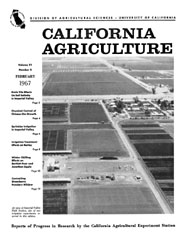


University of California
California Agriculture
|
|||
|
|||

Air view of Imperial Valley Field Station, site of two irrigation experiments reported in this edition.
February 1967
Volume 21, Number 2 |
|||
|
University of California, 1301 S. 46th St., Bldg. 478 Richmond, CA
|